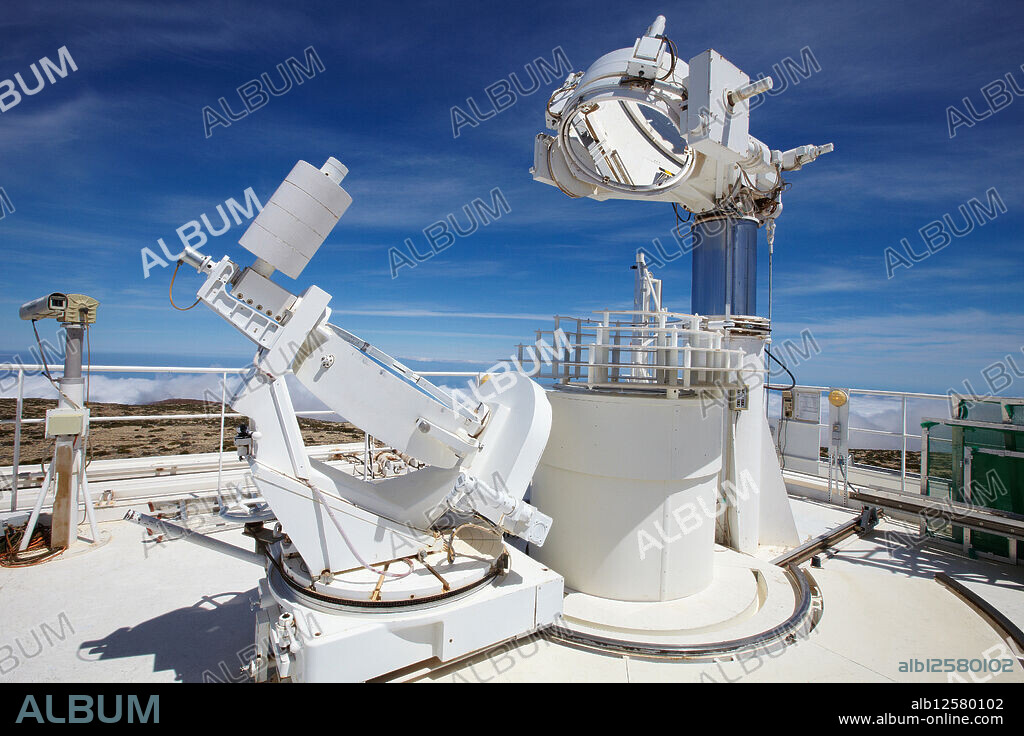alb12580102
The Vacuum Tower Telescope VTT, Solar Telescope, Observatorio del Teide, Tenerife, Canary Islands, Spain The VTT and the GREGOR are operated by four German institutes: the Astrophysikalisches Institut Potsdam, the Kiepenheuer-Institut f¸r Sonnenphysik Freiburg, chair, the Max-Planck-Institut f¸r Sonnensystemforschung Lindau, and the Universitts-Sternwarte Gttingen The telescope is used for scientific observations from mid April through mid December Typically 30 to 40 observing campaigns are carried out every year The VTT is a classical solar telescope: two coelostat mirrors at the top feed the sunlight into the telescope which spans 10 floors The primary mirror has a diameter of 70 cm and a focal length of 46 m The main advantage of the coelostat system is the non-rotating solar image in the laboratory The VTT offers several spacious optical laboratories for all kinds of optical setups Some of the laboratories are used for permanent installations, but there is always room for specialized or dedicated instruments Since 1998 an adaptive-optics system has been developed at the KIS The main components of the system are a Shack-Hartmann wavefront sensor with 36 sub-apertures, a deformable mirror and a high-speed digital camera A closed-loop bandwidth of about 70 Hz is achieved Since 2003, the AO system is permantly installed and available to all focal plane instruments At present, a multi-conjugated adaptive optics system is being developed at the VTT The VTT is equipped with several focal plane instruments for the observation of objects and physical processes on the solar surface Some of these instruments have been developed at partner institutions: Echelle Spectrograph KIS, 1988, MSDP Obs Meudon, 1989, Fabry-PÈrot Interferometer USG, 1992, Triple Etalon Solar Spectrometer KIS, 1997, Tenerife Infrared Polarimeter IAC, 1998, Polarimetric Littrow Spectrograph KIS + HAO, 2001.

|
Zu einem anderen Lightbox hinzufügen |
|
Zu einem anderen Lightbox hinzufügen |



Haben Sie bereits ein Konto? Anmelden
Sie haben kein Konto? Registrieren
Dieses Bild kaufen

Untertitel:
Siehe automatische Übersetzung
The Vacuum Tower Telescope VTT, Solar Telescope, Observatorio del Teide, Tenerife, Canary Islands, Spain The VTT and the GREGOR are operated by four German institutes: the Astrophysikalisches Institut Potsdam, the Kiepenheuer-Institut f¸r Sonnenphysik Freiburg, chair, the Max-Planck-Institut f¸r Sonnensystemforschung Lindau, and the Universitts-Sternwarte Gttingen The telescope is used for scientific observations from mid April through mid December Typically 30 to 40 observing campaigns are carried out every year The VTT is a classical solar telescope: two coelostat mirrors at the top feed the sunlight into the telescope which spans 10 floors The primary mirror has a diameter of 70 cm and a focal length of 46 m The main advantage of the coelostat system is the non-rotating solar image in the laboratory The VTT offers several spacious optical laboratories for all kinds of optical setups Some of the laboratories are used for permanent installations, but there is always room for specialized or dedicated instruments Since 1998 an adaptive-optics system has been developed at the KIS The main components of the system are a Shack-Hartmann wavefront sensor with 36 sub-apertures, a deformable mirror and a high-speed digital camera A closed-loop bandwidth of about 70 Hz is achieved Since 2003, the AO system is permantly installed and available to all focal plane instruments At present, a multi-conjugated adaptive optics system is being developed at the VTT The VTT is equipped with several focal plane instruments for the observation of objects and physical processes on the solar surface Some of these instruments have been developed at partner institutions: Echelle Spectrograph KIS, 1988, MSDP Obs Meudon, 1989, Fabry-PÈrot Interferometer USG, 1992, Triple Etalon Solar Spectrometer KIS, 1997, Tenerife Infrared Polarimeter IAC, 1998, Polarimetric Littrow Spectrograph KIS + HAO, 2001
Bildnachweis:
Album / Javier Larrea
Freigaben (Releases):
Model: Nein - Eigentum: Nein
Rechtefragen?
Rechtefragen?
Bildgröße:
5616 x 3744 px | 60.2 MB
Druckgröße:
47.5 x 31.7 cm | 18.7 x 12.5 in (300 dpi)
Schlüsselwörter:
 Pinterest
Pinterest Twitter
Twitter Facebook
Facebook Link kopieren
Link kopieren Email
Email
